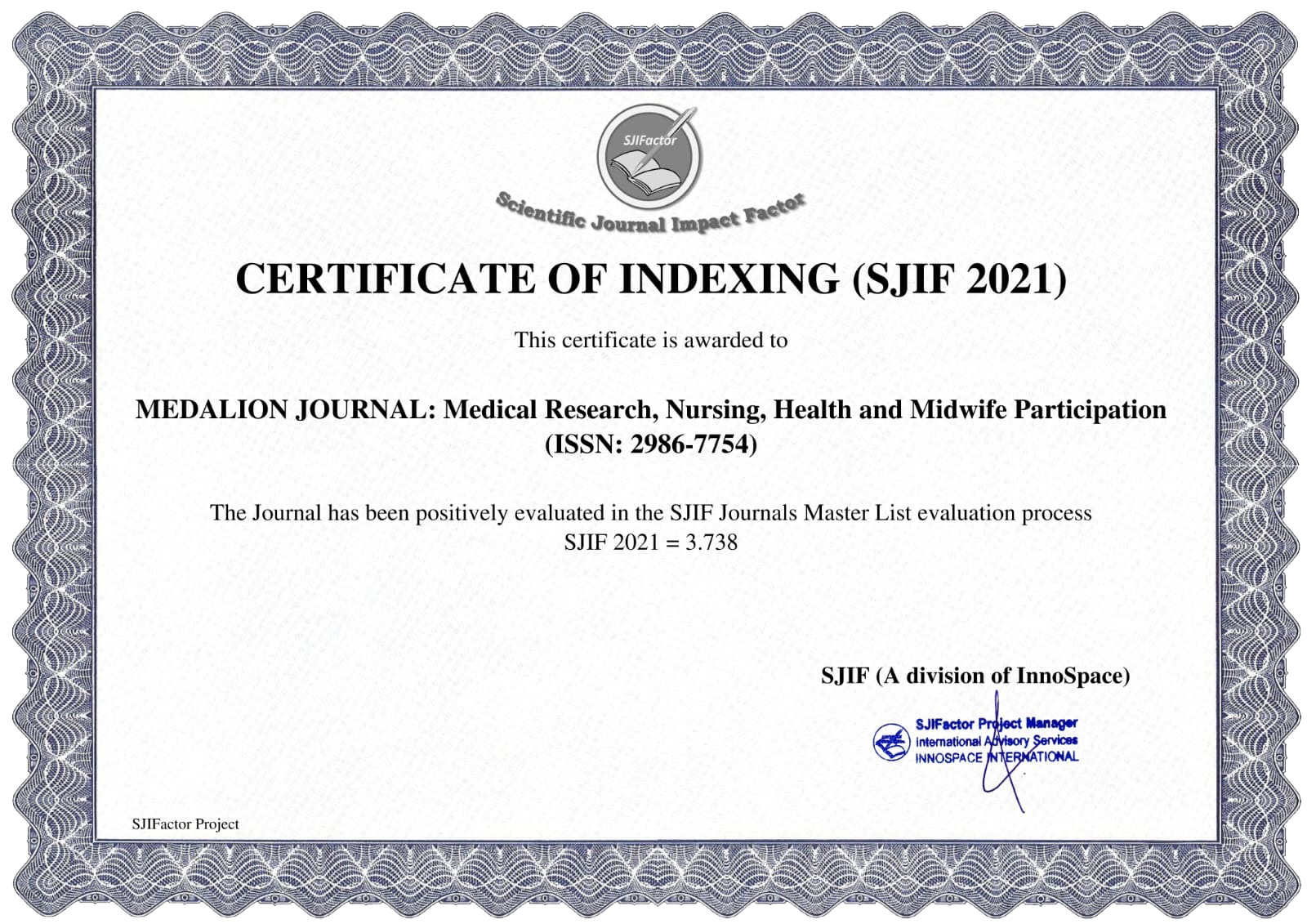PHYTOCHEMICAL SCREENING OF PAPAYA LEAF EXTRACT LAMPOH KEUDEE AREA AND ITS EFFECT ON STAPHYLOCOCCUS AUREUS BACTERIA
Main Article Content
Karunia Pratama
Aditya Candra
Suriatu Laila
Background: The plant known as papaya leaf (Carica papaya L) is a plant that commonly grows in tropical areas and is often used by local residents as an alternative treatment method to prevent bacterial growth because papaya leaves (Carica papaya L) have a number of pharmacological properties , one of which is the ability to kill Staphylococcus aureus bacteria. The aim of this research was to find out whether papaya leaf extract (Carica papaya L) could inhibit the growth of Staphylococcus aureus bacteria and whether papaya leaf extract (Carica papaya L) had antibacterial activity on Staphylococcus aureus bacteria. Method: This study tested the ethanol extract of papaya leaves (Carica papaya L) against Staphhylococcus aureus bacteria using experimental laboratory methods. The collected data was analyzed using nonparametric statistical analysis known as ANOVA. Results: According to the results of phytochemical research, papaya leaves (Carica papaya L) contain alkaloids, flavonoids, saponins, steroids and tannins. In papaya leaf extract which was tested against Staphylococcus aureus bacteria, there was an effective inhibitory power of papaya leaf ethanol extract with concentrations of 25%, 50% and 75%, with a concentration of 25% obtained an average inhibition zone of 6.2 mm, a concentration of 50% obtained an inhibition zone. an average of 6.7 mm and a concentration of 75% obtained an average inhibition zone of 7.8 mm. Conclusion: Antibacterial studies of Staphylococcus aureus reveal that papaya leaf extract has a growth inhibitory effect on this bacteria. As the leaf extract concentration increases, a larger zone of inhibition is formed.
Vindi Karisma E. Test of the antibacterial activity of papaya leaf extract (carica papaya l.) against escherichia coli and staphylococcus aureus bacteria. Farmasindo. 2019;3(2):2548–6667.
Hanina, Humaryanto, William Gading P, Indah Dewi Aurora W, Harahap H. Increasing the knowledge of Nurul Iman Islamic boarding school students about staphylococcus aureus infections on the skin using counseling methods. Medic. 2022;5(2):426–30.
Alzanado R, Yusuf M. Analysis of the levels of total alkaloid and flavonoid compounds in ethanol extract of papaya leaves (carica papaya l.) using UV-vis spectrophotometry. Malahayati pharmaceutical journal. 2022;5(1):108–20.
Candra A, Santi TD. Effectiveness of Papaya Leaf Extract (Carica Papaya L) as an anti-inflammatory. Aceh Medika Journal [Internet]. 2017 Oct;63–6. Available from: http://jurnal.abulyatama.ac.id/acehmedika
Rakhmawatie MD, Marfu'ati N. Making simplicia and techniques for preparing traditional medicines from red ginger and papaya leaves for dose standardization. Berdikari: journal of innovation and application of science and technology. 2023 Apr 20;11(1):12–24.
Candra A, Fahrimal Y, Yusni Y, Azwar A, Santi TD. Phytochemistry and antifatigue activities of Carica papaya leaves from geothermal, coastal and urban areas, Indonesia. Narra J. 2024 Mar 13;4(1):e321.
Candra A, Fahrimal Y, Dilla Santi T. Soil Analysis Test, Phytochemistry, and Anti-Inflammatory Ability of Papaya Leaf as an Ergogenic Antifatigue Candidate in Wistar Rats. The Third International Conference on innovations in Social Sciences Education and Engineering (ICoISSEE-3). 2023;3:1–13.
Indha Handyawati Putri D, Putri H, Trimulyono G. Inhibitory Test of Papaya Leaf Extract (Carica papaya L.) Against the Growth of Staphylococcus aureus Bacteria In Vitro. Bio Lantern [Internet]. 2023;12(2):172–8. Available from: https://journal.unesa.ac.id/index.php/lenterabio/index
Amalia S. Differences in the antibacterial power of parts of the papaya plant (carica papaya l.) on bacterial growth. Hutama Medika Journal [Internet]. 2021;2(4):1168–75. Available from: http://jurnalmedikahutama.com
Kirana Jati N, Tri Prasetya A, Mursiti S. Isolation, Identification, and Antibacterial Activity Test of Alkaloid Compounds in Papaya Leaves Article Info. MIPA Journal [Internet]. 2019;42(1):1–6. Available from: http://journal.unnes.ac.id/nju/index.php/JM
Dilla Santi T, Zakaria R, Candra A, Dharma Nauval M. Analysis of Active Compounds of Carica papaya, Averrhoa bilimbi, and Chromolaena odorata Leaves from Geothermal Area. In: AIP Conference Proceedings. American Institute of Physics Inc.; 2023.
Patria Tjahjani N, Chairunnisa A, Krisdianto A. Inhibitory Power of Ethanol Extract of Tekelan Leaves (Chromolaena Odorata L.) on the Growth of Staphylococcus Aureus Bacteria. Multidisciplinary Scientific Journal. 2023;2(5):1671–7.
Astridwiyanti AAB, Mahendra AN, Dewi NWS. Test the effectiveness of ethanol extract of red dragon fruit peel (Hylocereus polyrhizus) against Staphylococcus aureus ATCC 25923 in vitro. Medical Science Digest. 2019 Sep 2;10(3).
Morales G, Sierra P, Mancilla A, Paredes A, Loyola LA, Gallardo O, et al. Secondary metabolites from four medicinal plants from northern chile: antimicrobial activity and biotoxicity against artemia salina. Journal of the Chilean Chemical Society. 2003 Jun;48(2).
Ardila S, Wahab A, Candra A. Antibacterial effectiveness test of kersen leaves (muntingia calabural l) on escherichia coli. Medalionjournal [Internet]. 2023;4:100–5. Available from: https://medalionjournal.com/
Wulandari DR, Syafitri KA, Musa IM, Sodiqah Y, Gayatri W. Test of the Antibacterial Effectiveness of Papaya Leaf Extract (Carica Papaya Linn) on the Growth of Staphylococcus Aureus Bacteria. Fakumi Medical Journal: Medical Student Journal. 2022;2(10):2022.
Santi TD, Siregar TN, Sutriana A, Andini R, Candra A. Phytochemical test and optimization of transdermal patches of Carica papaya extract: Formulation design of candidate drug for wound healing. Biodiversity. 2022;23(6):2904–13.









